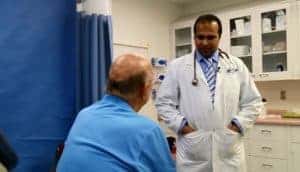Precancerous Lesion on Pancreas Removed Without Surgery
| Sept. 7, 2017 | “I never had any symptoms. That, to me, is the scariest part about it.”
Ermer “E.O.” Huddleston, 80, wasn’t expecting anything abnormal when he went to his Conway gastroenterologist for an endoscopy, where a tube with a camera and light is inserted in the throat to look at the digestive tract.
But his physician noticed an area near his pancreas he felt needed attention. The doctor ordered a biopsy and referred Huddleston to Benjamin Tharian, M.D, the director of advanced endoscopy who sees patients in the UAMS gastroenterology clinic.
“I guess he saw in the image a large, irritated spot. I never felt anything,” Huddleston said.
Tharian said Huddleston had an ampullary adenoma, a precancerous lesion at the opening of his pancreatic and biliary drainage tubes, and that it was good that the doctor noticed it early.
“If it had been left too long, even surgery may not have been an option,” Tharian said.
There are two treatments for an ampullary adenoma, Tharian says. One is to remove the lesion endoscopically by inserting a tube down the throat with a camera and light on the end. It’s minimally invasive and may require only an overnight hospital stay. The other option requires major surgery to remove part of the pancreas, part of the bile duct and part of the stomach. It’s a complex operation known as a Whipple procedure, which is done normally for pancreatic cancer.
Tharian says the endoscopic option ampullectomy has been done in other states. But the operation he did for Huddleston was a first for Arkansas.
Tharian began by doing another endoscopy to confirm Huddleston had an ampullary adenoma. Then he did an endoscopic ultrasound.
“That essentially looks underneath the visible surface,” Tharian said. “We do this to see if the lesion is superficial or if it has grown deeper into the pancreas, needing invasive surgery.”
Tharian found that Huddleston’s lesion was treatable endoscopically. Next, Tharian carefully examined the area through a special endoscope in a procedure known as Endoscopic Retrograde Cholangio-Pancreatography or ERCP.
“During the ERCP, we opened up the pancreatic and bile duct and cut the lesion, the same way polyps are removed from the bowel. Then, I placed two temporary stents inside both the ducts.”
Tharian says the stents are necessary to keep the bile duct and pancreatic duct draining. Otherwise, scarring would lead to blockage that could cause pancreatitis or jaundice.
Huddleston had to stay overnight in the hospital because Tharian says the risk of pancreatitis is highest the first 24 hours following the procedure. It’s significantly less time than the possible seven-day stay that would have come with the Whipple procedure, in addition to being safer.
“He did very well,” Tharian said. “We sent the specimen to the lab and they confirmed it was a complete removal of the lesion.”
Huddleston’s wife, Mary, says this was their first experience with UAMS. She says she was pleased with the care and kindness of everyone she met.
“I don’t think I saw anyone that was having a bad day,” she said. “They kept me informed throughout the procedure and thankfully everything went smoothly.”
Huddleston will need to have follow-up endoscopies with his gastroenterologist at regular intervals and possible biopsies to make sure there is no recurrence of the disease.
Tharian says he has done five similar treatments since Huddleston’s procedure.
“Not every patient is a candidate for the endoscopic treatment,” Tharian says. “The main thing is to get to the lesion early enough. It’s often missed because the condition is asymptomatic and the lesion could be subtle and easily missed if the ampulla is not carefully examined.”
Huddleston is grateful his doctor caught the problem and avoided a complicated surgery, increased risks (especially with his previous history of cardiac bypass surgery) and long recovery. Having just turned 80, he looks forward to continuing the things he enjoys including spending time with his wife, instrumental music and playing golf.
“It sounds like a real scary thing, to me, that someone could have it and not ever know it until it was way too late,” Huddleston said. “I’m glad my doctor spotted it early and I’m grateful to Dr. Tharian.”

